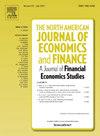波动率价差能否完全捕捉到买卖权平价的违规行为?
IF 3.9
3区 经济学
Q1 BUSINESS, FINANCE
North American Journal of Economics and Finance
Pub Date : 2025-08-11
DOI:10.1016/j.najef.2025.102493
引用次数: 0
摘要
看跌期权平价(PCP)是一种在完整市场中看涨期权和看跌期权价格及其标的之间众所周知的关系。它在不完全市场中的违规行为也是众所周知的。然而,与之前文献中记录的所有原因不同,我们在本文中通过令人信服的经验证据表明,看跌期权和看涨期权的密度扩散也被“归咎于”这种违规行为。我们还提供了一个理论框架来解释不完全市场中的这种不平衡。本文章由计算机程序翻译,如有差异,请以英文原文为准。
Can volatility spread fully capture the put–call parity violation?
Put–call parity (PCP) is a well-known relationship between call and put option prices and their underlying for complete markets. It is equally well known for its violation in incomplete markets. However, unlike all the previously documented reasons in the literature, we show in this paper, through convincing empirical evidence, that the density spread of the put and call is also “blamed” for such a violation. We also provide a theoretical framework to financially explain such an imbalance in incomplete markets.
求助全文
通过发布文献求助,成功后即可免费获取论文全文。
去求助
来源期刊
CiteScore
7.30
自引率
8.30%
发文量
168
期刊介绍:
The focus of the North-American Journal of Economics and Finance is on the economics of integration of goods, services, financial markets, at both regional and global levels with the role of economic policy in that process playing an important role. Both theoretical and empirical papers are welcome. Empirical and policy-related papers that rely on data and the experiences of countries outside North America are also welcome. Papers should offer concrete lessons about the ongoing process of globalization, or policy implications about how governments, domestic or international institutions, can improve the coordination of their activities. Empirical analysis should be capable of replication. Authors of accepted papers will be encouraged to supply data and computer programs.

 求助内容:
求助内容: 应助结果提醒方式:
应助结果提醒方式:


